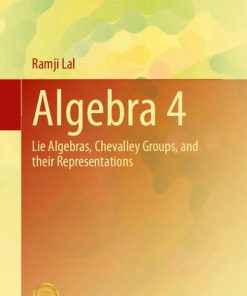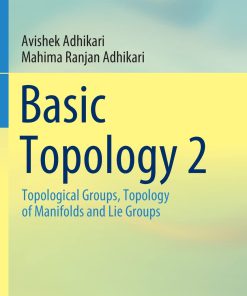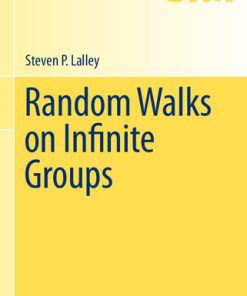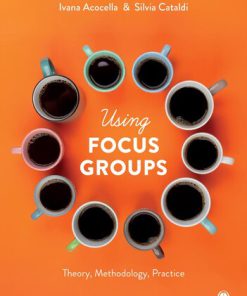Theory of Groups and Groups Representations of Groups and Lie Algebras Applications 1st Edition by Alexey Isaev, Valery Rubakov 9811217408 9789811217401
$50.00 Original price was: $50.00.$25.00Current price is: $25.00.
Theory of Groups and Groups Representations of Groups and Lie Algebras Applications 1st Edition by Alexey Isaev, Valery Rubakov – Ebook PDF Instant Download/Delivery: 9811217408, 9789811217401
Full download Theory of Groups and Groups Representations of Groups and Lie Algebras Applications 1st Edition after payment
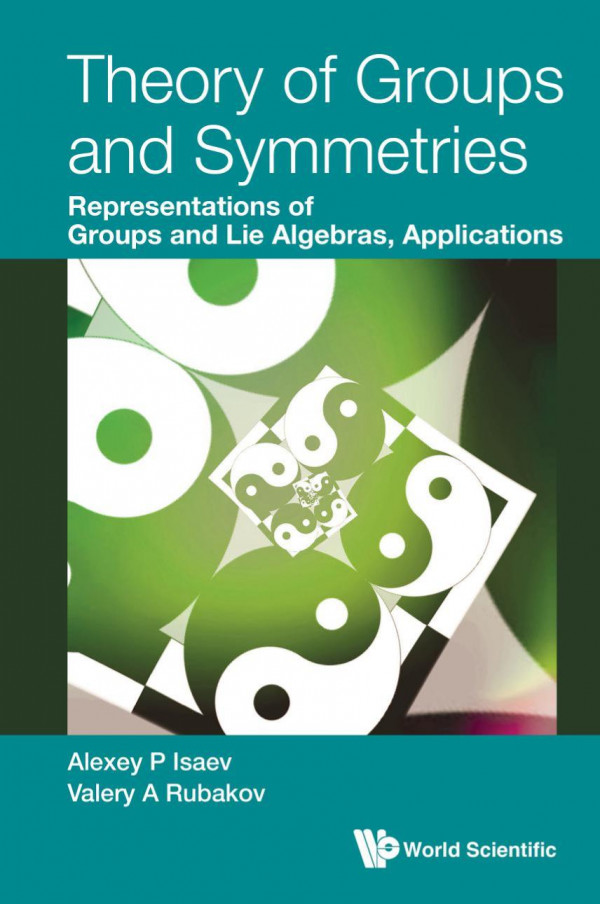
Product details:
ISBN 10: 9811217408
ISBN 13: 9789811217401
Author: Alexey P. Isaev, Valery A. Rubakov
This book is a sequel to the book by the same authors entitled Theory of Groups and Symmetries: Finite Groups, Lie Groups, and Lie Algebras.The presentation begins with the Dirac notation, which is illustrated by boson and fermion oscillator algebras and also Grassmann algebra. Then detailed account of finite-dimensional representations of groups SL(2, C) and SU(2) and their Lie algebras is presented. The general theory of finite-dimensional irreducible representations of simple Lie algebras based on the construction of highest weight representations is given. The classification of all finite-dimensional irreducible representations of the Lie algebras of the classical series sℓ(n, C), so(n, C) and sp(2r, C) is exposed.Finite-dimensional irreducible representations of linear groups SL(N, C) and their compact forms SU(N) are constructed on the basis of the Schur–Weyl duality. A special role here is played by the theory of representations of the symmetric group algebra C[Sr] (Schur–Frobenius theory, Okounkov–Vershik approach), based on combinatorics of Young diagrams and Young tableaux. Similar construction is given for pseudo-orthogonal groups O(p, q) and SO(p, q), including Lorentz groups O(1, N-1) and SO(1, N-1), and their Lie algebras, as well as symplectic groups Sp(p, q). The representation theory of Brauer algebra (centralizer algebra of SO(p, q) and Sp(p, q) groups in tensor representations) is discussed.Finally, the covering groups Spin(p, q) for pseudo-orthogonal groups SO↑(p, q) are studied. For this purpose, Clifford algebras in spaces Rp, q are introduced and representations of these algebras are discussed.
Theory of Groups and Groups Representations of Groups and Lie Algebras Applications 1st Table of contents:
1 Dirac Notations
1.1 Bra and Ket Vectors. Coordinate and Momentum Representations
1.2 Fock Representation. (Anti)holomorphic Representations
1.3 Clifford Algebra and Free Fermion Algebra
1.3.1 Clifford algebra
1.3.2 Fock representation for free fermion algebra
1.3.3 Grassmann algebra
2 Finite-Dimensional Representations of Lie Algebras su(2) and sℓ(2, C) and Lie Groups SU(2) and SL(2, C)
2.1 Finite-Dimensional Representations of Lie Algebras su(2) and sℓ(2, C)
2.2 Differential Realization of Lie Algebra sℓ(2, C) and Highest Weight Representations
2.2.1 Realization of Lie algebra sℓ(2, C) in terms of differential operators
2.2.2 Highest weight representations of differential realizations of sℓ(2, C)
2.2.3 Coherent states for Lie algebra sℓ(2, C)
2.3 Finite-Dimensional Representations of Groups SU(2) and SL(2, C)
2.3.1 Parameterizations of Group SU(2)
2.3.2 Finite-dimensional representations of groups SU(2), SL(2, C) and SO(3). Tensor representations — Wigner functions
2.3.3 Spherical functions on S2 = SU(2)/U(1). Laplace operators on SU(2) and SU(2)/U(1)
2.4 Tensor Product of Representations of SU(2) and Clebsch–Gordan Series
2.4.1 Clebsch–Gordan expansion
2.4.2 Highest weight representations in Tj1 ⊗ Tj2
2.4.3 Heisenberg spin chain
2.4.4 Calculating Clebsch–Gordan coefficients
2.4.5 Properties of Clebsch–Gordan coefficients and 3-j symbols
2.5 Tensor Operators and 3n-j Symbols
2.5.1 Tensor operators and Wigner–Eckart theorem
2.5.2 Racah coefficients and 3n-j symbols
2.5.3 6-j symbols and associativity of product of representations
2.5.4 Calculating 6-j symbols. Schwinger method
3 Representations of Simple Lie Algebras. Weight Theory
3.1 Root Systems of Simple Lie Algebras
3.1.1 Root systems of Lie algebra sℓ(n, C), so(n, C) and sp(2r, C)
3.1.2 Root systems of exceptional Lie algebras
3.1.3 Weyl group. Dual root systems
3.2 Representations and Weights
3.3 Weight Lattice
3.4 Classification of Finite-Dimensional Irreducible Representations
3.4.1 Highest weight representations
3.4.2 Fundamental weights and representations of Lie algebras sℓ(n, C) , so(n, C) and sp(2r, C)
3.4.3 Quadratic Casimir operator
3.5 Weyl Character Formula for Representations of Compact Simple Lie Groups
3.5.1 Weyl denominator and Weyl character formula
3.5.2 Applications. Explicit formulas for characters and dimensions of representations of groups SU(r +1) , SO(n) and USp(2r)
4 Finite-Dimensional Representations of Algebras sℓ(N, C), su(N) and Groups SL(N, C) and SU(N)
4.1 Preliminaries
4.2 Action of Group Sr in Tensor Product of Defining Representations
4.3 Representations of Symmetric Group I. Young Symmetrizers
4.3.1 Young tableaux and Young symmetrizers
4.3.2 Young symmetrizers and idempotents. Irreducible representations of group Sr and their dimensions
4.4 Finite-Dimensional Irreducible Representations of Groups SU and SL
4.4.1 Finite-dimensional irreducible representations of SL(N, C) and SU(N) in spaces of symmetrized tensors
4.4.2 Dimensions of irreducible representations of groups SL(N, C) and SU(N)
4.4.3 Co-defining and adjoint representations of groups SL(N, C) and SU(N)
4.4.4 Quarks, SU(3) -symmetry and its breaking
4.5 Representations of Symmetric Group II. Young–Frobenius Theory
4.5.1 Idempotents and irreducible representations of associative algebras. Peirce decomposition
4.5.2 Orthogonality and completeness of Young symmetrizers
4.5.3 Schur–Weyl duality
4.6 Representations of Symmetric Group III. Okounkov–Vershik Approach
4.6.1 Jucys–Murphy elements and intertwining operators in algebra C[Sn]
4.6.2 Idempotents and spectrum of Jucys–Murphy operators
4.6.3 Colored Young graph and branching rule for representations
4.6.4 Young graph and inductive construction of idempotents
4.6.5 Projection operators and characters of irreducible representations of U(N). Symmetric polynomials
4.7 Concluding Remarks. Gelfand–Tsetlin Basis
5 Finite-Dimensional Representations of Groups SO, Sp and Lie Algebras so, sp
5.1 Tensor Representations of Groups O(N, C), SO(N, C) and Their Subgroups O(p, q), SO(p, q)
5.1.1 Pseudo-orthogonal group O(p, q) and Lie algebra so(p, q)
5.1.2 Tensor representations of groups O(p, q)
5.1.3 Extracting irreducible representations of groups O(p, q) and SO(p, q) from representation T⊗r
5.1.4 Irreducible tensor representations of orthogonal groups. Oscillating Young tableaux
5.2 Brauer Algebra Brn and Its Representations
5.2.1 Brauer algebra Brn. Jucys–Murphy elements for Brn
5.2.2 Intertwining elements and idempotents in algebra Brn. Spectrum of Jucys–Murphy operators
5.2.3 Oscillating Young tableaux and their content vectors
5.2.4 Oscillating Young graph for algebra Brn
5.2.5 Primitive idempotents in Brauer algebra and invariant projectors for representations of orthogonal groups
5.3 Tensor Representation of Groups Sp(2r, C) and Their Subgroups Sp(2r, R), USp(2r), Sp(p, r − p)
5.4 Spinor Representations of Lie Algebras so(N, C)
5.4.1 Spinor representations of Lie algebras so(2r, C)
5.4.2 Spinor representations of Lie algebras so(2r + 1, C)
6 Groups Spin(p, q) and Their Finite-Dimensional Representations
6.1 Clifford Algebras and Their Representations
6.1.1 Real Clifford algebras Cℓ(p,q)
6.1.2 Matrix representations of complex Clifford algebras CℓN and their real forms Cℓ(p,q)
6.1.3 Weyl representations of Clifford algebras CℓN and Cℓ(p,q)
6.2 Spinor Groups Pin(p, q) and Spin(p, q)
6.2.1 Definitions of spinor groups Pin(p, q) and Spin(p, q)
6.2.2 Representations of algebras spin(p, q) and groups Spin(p, q)
6.3 Conjugation Matrices
6.3.1 Conjugation matrices B, C, D for representations of algebra Cℓ(p, q), and their properties
6.3.2 Conjugation matrices B, C, D and structure of groups Spin(p, q). Group Spin(8)
6.4 Dirac, Weyl and Majorana Spinors in Spaces Rp, q
6.4.1 Spinors in spaces Rp, q and their tensor products
6.4.2 Charge conjugation of spinors in spaces Rp, q
6.4.3 Algebra Cℓ(1, N−1) and spinor group Spin(1, N − 1). Spinors in Minkowski space R1, N−1
6.4.4 Fierz identities for multi-dimensional spinors
7 Solutions to Selected Problems
7.1 Problem 1.3.6 of Section 1.3.3
7.2 Problem 1.3.7 of Section 1.3.3
7.3 Problem2.2.13ofSection2.2.3
7.4 Problem 2.3.4 of Section 2.3.2
7.5 Problem 2.3.6 of Section 2.3.3
7.6 Problem 2.3.7 of Section 2.3.3
7.7 Problem 2.3.11 of Section 2.3.3
7.8 Problem 2.5.4 of Section 2.5.2
7.9 Problem 2.5.15 of Section 2.5.4
7.10 Problem 3.3.1 of Section 3.3
7.11 Problem 3.4.5 of Section 3.4.2
7.12 Problems 4.3.2 and 4.3.3 of Section 4.3.1
7.13 Problem 4.3.10 of Section 4.3.2
7.14 Problem 4.3.11 of Section 4.3.2
7.15 Problem 4.5.7 of Section 4.5.1
7.16 Problem 4.6.9 of Section 4.6.5
7.17 Problem 4.6.11 of Section 4.6.5
7.18 Problem 4.7.1 of Section 4.7
7.19 Problem 5.1.3 of Section 5.1.3
7.20 Problem 5.1.5 of Section 5.1.3
7.21 Problem 5.3.4 of Section 5.3
7.22 Problem 6.2.2 of Section 6.2.1
7.23 Problem 6.2.4 of Section 6.2.1
7.24 Problem 6.3.5 of Section 6.3.2
7.25 Problem 6.3.6 of Section 6.3.2
7.26 Problem 6.3.10 of Section 6.3.2
7.27 Problem 6.4.3 of Section 6.4.1
7.28 Problem 6.4.13 of Section 6.4.3
People also search for Theory of Groups and Groups Representations of Groups and Lie Algebras Applications 1st:
5 types of groups
an introduction to the theory of groups pdf
3 theories of representation
3 types of groups
Tags:
Alexey Isaev,Valery Rubakov,Groups,Representations
You may also like…
Mathematics - Algebra
Algebra 4: Lie Algebras, Chevalley Groups, and their Representations 1st Edition Ramji Lal
Mathematics - Symmetry and group
Groups and Symmetry: Theory and Applications 1st Edition Bijan Davvaz
Mathematics - Geometry and Topology
Mathematics - Geometry and Topology
Mathematics - Probability
Random Walks on Infinite Groups 1st Edition Steven P. Lalley
Education Studies & Teaching - Educational Guidance & Counseling
Using Focus Groups Theory Methodology Practice Ivana Acocella
Uncategorized
Mathematics - Number Theory
Algebraic Groups and Number Theory 2nd Edition by Platonov, Andrei, Igor 9780521113618 052111361X


